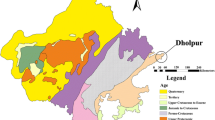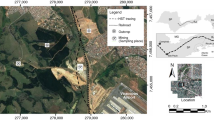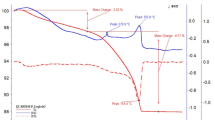Abstract
Thermal analysis is a useful tool for determination of the rock‘s thermal behavior. The thermal behavior of the rock is affected by both its composition and structure. This study presents the application of thermogravimetric, differential thermal, and thermomechanical analyses for the characterization of the selected Czech sandstone samples. The detailed study of mineralogical composition was carried out by FTIR spectroscopy, X-ray diffraction, and optical microscopy. Thermal expansion during heating up to 1,000 °C, together with the coefficient of thermal expansion showed almost the same values for all the studied sandstone samples. Nevertheless, the residual thermal expansion varied depending mainly on the composition. In the case of higher content of quartz, the thermal expansion showed higher values. With increase of carbonate, glauconite, or clay mineral volume, the residual thermal expansion decreased. Factors such as grain size or shape of particles did not significantly influence the observed thermal expansion values.

















Similar content being viewed by others
References
Procházka J. Kvalitativní charakteristika cenomanských pískovců hořického hřbetu (Qualitative characteristics of the Cenomanian sandstones of the Horice bridge). Geochemie. 1986;21:200–32 (in Czech with English summary).
Pospíšil P. Cretaceous sandstones in Moravia and Silesia and their application as building and ornamental stones. Bull Geosci. 2004;79(3):183–93.
Rawlley RK. Mineralogical investigations on an Indian glauconitic sandstone of Madhya Pradesh state. Appl Clay Sci. 1994;8:449–65.
Andreozzi M, et al. Geochemical and mineralogical criteria for the identification of ash layers in the stratigraphic framework of a foredeep; the Early Miocene Mt. Cervarola Sandstones, northern Italy. Chem Geol. 1997;137:23–39.
Kiminami K, Fujii K. The relationship between major element concentration and grain size within sandstones from four turbidite sequences in Japan. Sediment Geol. 2007;195:203–15.
Khidir A, Catuneanu O. Reservoir characterization of Scollard-age fluvial sandstones, Alberta foredeep. Mar Pet Geol. 2010. doi:10.1016/j.marpetgeo.2010.05.001.
Ip KH, Stuart BH, Thomas PS, Ray AS. Thermal characterization of the clay binder of heritage Sydney sandstones. J Therm Anal Calorim. 2008;92:97–100.
Yas E, et al. Determination of the thermal conductivity from physico-mechanical properties. Bull Eng Geol Environ. 2008;67:219–25.
Martinec P, Vavro M, Ščučka J, Mašláň M. Properties and durability assessment of glauconitic sandstone: a case study on Zamel sandstone from the Bohemian Cretaceous Basin (Czech Republic). Eng Geol. 2009. doi:10.1016/j.enggeo.2009.08.005.
Jeng FS, et al. Influence of petrographic parameters on geotechnical properties of tertiary sandstones from Taiwan. Eng Geol. 2004;73:71–91.
Baud P, Klein E, Wong T. Compaction localization in porous sandstones: spatial evolution of damage and acoustic emission activity. J Struct Geol. 2004;26:603–24.
Bésuelle P. Compacting and dilating shear bands in porous rocks: theoretical and experimental conditions. J Geophys Res. 2001;106:1335–42.
El Bied A, Sulem J, Martineau F. Microstructure of shear zones in Fontainebleau sandstone. Int J Rock Mech Min Sci. 2002;39:917–32.
Said S, et al. Use of X-ray powder diffraction for quantitative analysis of carbonate rock reservoir samples. Powder Technol. 2007;175:115–21.
Blanc F, et al. Estimate of clay minerals amounts from XRD pattern modeling. Phys Chem Earth. 2007;32:135–44.
Chmielová M, Weiss Z. Determination of structural disorder degree using an XRD profile fitting procedure. Application to Czech kaolins. Appl Clay Sci. 2002;22:65–74.
Farmer VC. The infrared spectra of minerals. London: Mineralogical Society; 1974.
Madejová J, Komadel P. Baseline studies of the clay minerals society source clays: infrared methods. Clays Clay Miner. 2001;49(5):410–32.
Krivácsy Z, Hlavay J. Determination of quartz in dust samples by diffuse reflection FTIR spectroscopy. J Mol Struct. 1993;294:251–4.
Oinuma K, Hayashi H. Infrared study of mixed-layer clay minerals. Am Mineral. 1965;50:1213–27.
Vaculíková L, Plevová E. The identification of clay minerals and micas in sedimentary rocks. Acta Geodyn Geomater. 2005;2(2):163–71.
Fuente S, Cuadros J, Linares J. Early stages of volcanic tuff alteration in hydrothermal experiments: formation of mixed-layer illite-smectite. Clays Clay Miner. 2002;50:578–90.
Hatakeyama T, Liu Z. Handbook of thermal analysis. New York: Wiley; 1998.
Blažek A. Book of thermal analysis. Prague: SNTL; 1974.
Muller F, Drits V, Plancon A, Robert JL. Structural transformation of 2:1 dioctahedral layer silicates during dehydroxylation–rehydroxylation reactions. Clays Clay Miner. 2000;48:572–85.
Smykatz-Kloss W, Klinke W. The determination of authigenic quartz in porous sedimentary rocks by means of differential scanning calorimetry. J Therm Anal Calorim. 1994;42:85–97.
Plevová E, Kožušníková A, Vaculíková L, Simha Martynková G. Thermal behavior of selected Czech marble samples. J Therm Anal Calorim. 2010. doi:10.1007/s10973-010-0907-5.
Price DM. Principles of thermal analysis and calorimetry. Cambridge: The Royal Society of Chemistry; 1994.
Obara B, Kožušníková A. Utilisation of the image analysis method for the detection of the morphological anisotropy of calcite grains in marble. Comput Geosci. 2007;11(4):275–81.
Leiss B, Weiss T. Fabric anisotropy and its influence on physical weathering of different types of Carrara marbles. J Struct Geol. 2000;22:1737–45.
Luque A, et al. Anisotropic behaviour of White Macael marble used in the Alhambra of Granada (Spain). The role of thermohydric expansion in stone durability. Eng Geol. 2009. doi:10.1016/j.enggeo.2009.06.015.
Thompson GR, Hower J. The mineralogy of glauconite. Clays Clay Miner. 1975;23:289–300.
Acknowledgements
This study was supported by the Czech Science Foundation, the projects: No. 105/08/1398, No. 105/09/P397, No. 105/07/P416, and by the Research plan No. AVOZ 30860518. The authors would like to thank George Laynr for controlling and correcting the use of English in this article.
Author information
Authors and Affiliations
Corresponding author
Rights and permissions
About this article
Cite this article
Plevová, E., Vaculíková, L., Kožušníková, A. et al. Thermal study of sandstones from different Czech localities. J Therm Anal Calorim 103, 835–843 (2011). https://doi.org/10.1007/s10973-010-1129-6
Received:
Accepted:
Published:
Issue Date:
DOI: https://doi.org/10.1007/s10973-010-1129-6




